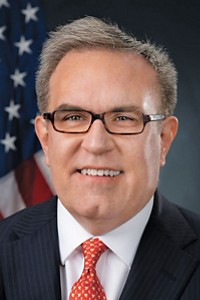Advertisement
Grab your lab coat. Let's get started
Welcome!
Welcome!
Create an account below to get 6 C&EN articles per month, receive newsletters and more - all free.
It seems this is your first time logging in online. Please enter the following information to continue.
As an ACS member you automatically get access to this site. All we need is few more details to create your reading experience.
Not you? Sign in with a different account.
Not you? Sign in with a different account.
ERROR 1
ERROR 1
ERROR 2
ERROR 2
ERROR 2
ERROR 2
ERROR 2
Password and Confirm password must match.
If you have an ACS member number, please enter it here so we can link this account to your membership. (optional)
ERROR 2
ACS values your privacy. By submitting your information, you are gaining access to C&EN and subscribing to our weekly newsletter. We use the information you provide to make your reading experience better, and we will never sell your data to third party members.
Regulation
U.S. EPA chief proposes that agency regulations rely only on publicly available data
Debate swirls around whether proposal will improve or hinder agency’s work
by Cheryl Hogue
April 26, 2018
| A version of this story appeared in
Volume 96, Issue 18

A recently proposed rule could significantly restrict the U.S. Environmental Protection Agency’s ability to protect Americans’ health and the environment from pollution. Under EPA Administrator Scott Pruitt’s proposal, the agency would be limited to using publicly available scientific data.
Pruitt’s move would affect scientific studies, models, and analyses that are critical for determining regulatory standards—including information used to estimate the health risks posed by individual chemicals and weigh the costs and benefits of regulations. Such regulations dictate allowable levels of air or drinking water pollution, how pesticides may be used, controls on production of new commercial chemicals, and cleanup requirements for hazardous waste sites.
Pruitt’s move is to ensure that critical data underlying environmental regulations “are publicly available in a manner sufficient for independent validation,” the proposal says. “Using scientific information that can be independently validated will lead to better outcomes” and strengthen public confidence in EPA’s decisions, the proposal adds.
“The ability to test, authenticate, and reproduce scientific findings is vital for the integrity of rulemaking process,” Pruitt says. “Americans deserve to assess the legitimacy of the science underpinning EPA decisions that may impact their lives.”
Others say that restricting EPA to using publicly available information would keep key data out of the agency’s hands.
“This proposal appears to be an attempt to remove valid and relevant scientific evidence from the rulemaking process,” says Rush Holt, CEO of the American Association for the Advancement of Science (AAAS).
Glenn S. Ruskin, a spokesperson for the American Chemical Society, concurs. “EPA has a well-regarded process for incorporating vital scientific insights into regulations. Any changes must ensure that EPA retains the ability to access and utilize the most appropriate sources of scientific information, while protecting important proprietary and personal information,” Ruskin says. ACS publishes C&EN.
The proposal claims the standards it would set regarding public availability of data are “consistent with data access requirements for major scientific journals like Science, Nature, and Proceedings of the National Academy of Sciences.”
However, publishers’ requirements recognize differences across scientific fields and that all data cannot be fully shared in every case, says Jeremy Berg, editor-in-chief of the Science family of journals.
“Science requires that all data used in the analysis must be available to any researcher for purposes of reproducing or extending the analysis,” Berg says. But journal policies also have the flexibility to accommodate situations in which data cannot be shared openly, for privacy or other concerns. “Importantly, the merits of such studies can still be judged,” Berg says.
“Excluding relevant studies simply because they do not meet rigid transparency standards will adversely affect decision-making processes,” said Berg along with top editors of Nature, Public Library of Science journals, Proceedings of the National Academy of Sciences, and Cell Press in a joint statement released on April 30.
In drafting the proposal, Pruitt drew from industry-backed legislation championed by Rep. Lamar Smith (R-Texas), chairman of the U.S. House of Representative’s Science, Space & Technology Committee. Smith wants EPA to rely solely on data that are available for independent analysis and for which there is “substantial reproduction of research results.” The House passed two similar versions of Smith’s bills against what he calls “secret science” at EPA, most recently H.R. 1430 in March 2017. Sen. Mike Rounds (R-S.D.), introduced Smith’s bill in the Senate but the measure went nowhere.
Advertisement
Smith’s crusade was triggered by two epidemiology studies conducted independently in the 1990s by Harvard University and the American Cancer Society. The studies linked health problems to exposure to particulate matter air pollution. EPA used the results as a scientific basis for tighter Clean Air Act regulations that many in industry, including chemical makers, have fought vigorously. Smith, who sides with industry, sought confidential raw data from the studies, even issuing a subpoena to force EPA to hand over the information. But the agency did not possess the data, and the study authors resisted Smith’s attempts to get the information, citing protection of participants’ privacy.
Smith dismisses concerns by what he calls the “liberal media” and “environmental alarmists” about the possibilities of exposing personal information. Redaction of personally identifiable information will fix the problem, and those who need particular data to redo an analysis can be required to maintain participants’ confidentiality, he says.
However, protecting the confidentiality of epidemiology study participants isn’t as easy as simply redacting their names, says Gretchen Goldman, research director of the Union of Concern Scientists’ Center for Science & Democracy. For epidemiology studies of the impact air pollution has on health, making public information such as the participants’ locations—which may be home addresses—and their specific ailments could easily unmask their identities, she explains. The privacy risk may deter people from participating in future studies, Goldman continues. Also, making study data public may well go astray of confidentiality protections established by institutional review boards, Goldman adds.
Studies with participant privacy concerns aren’t the only type of data that the proposal could affect. AAAS’s Holt points out, “Other studies rely on public and private-sector funding sources that may limit access to underlying data.”
The proposal says it would not compel “disclosure of any confidential or private information in a manner that violates applicable legal and ethical protections.” Other federal agencies including the Department of Health & Human Services, National Institute of Standards & Technology, and Census Bureau have tools and methods to unlink private information from data, the proposal says.
But “if put into practice, EPA could prohibit, or make it incredibly costly, for the agency to use a wide swath of high-quality scientific research,” Holt says. “Despite the political rhetoric, there are existing federal guidelines that require access to the scientific information used for federal policies and regulations.”
After Pruitt signed the proposal, the American Chemistry Council, the largest lobbying group of the U.S. chemical industry, commended him and the EPA staff for work “to ensure that best available science and the weight of the scientific evidence is the basis for the regulatory decision-making process.”
But ACC also wants the final version of the rule to protect personal privacy, confidential business information, proprietary interest, and intellectual property rights from public disclosure. Chemical makers do not want competitors to have access to the toxicity and efficacy studies conducted in advance of marketing their products.
The proposal recognizes this concern. It asks for comments from the public on how to balance protections for copyrighted or confidential business information with greater public access to the scientific data EPA uses.
It also includes an escape clause that would allow the EPA administrator to exempt individual regulatory decisions from the new requirements if complying with the criteria is impractical.
Yet the proposal wouldn’t require EPA to disclose whether it used confidential data or proprietary models as a basis for its regulatory decisions, points out Richard Denison, lead senior scientist with the Environmental Defense Fund, an activist group. “EPA may use this ambiguity to selectively consider or ignore nondisclosed data and models to reach industry-preferred outcomes,” Denison says.
Pruitt signed the proposal at an April 24 ceremony, flanked by legislators Smith and Rounds before an audience of climate change skeptics and conservative critics of environmental protections. The agency will take formal public comment on the plan and revise it before making it final. If the Trump Administration puts the final version on a fast track, this could happen later this year, even though EPA often takes 18 months to years to finalize regulations.
Update:
This article was revised on April 30, 2018, to reflect a joint statement by editors of five scientific journals.




Join the conversation
Contact the reporter
Submit a Letter to the Editor for publication
Engage with us on Twitter